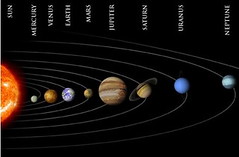345
jupiter is the largest planet in the solar system followed in descending diametric order by saturn, uranus, neptune, earth, venus, mars and mercury.

that would place earth at number five for those of you with enough fingers.
i wouldve included pluto in the mix but a bunch of knuckleheads in the front office formally decided to make the former smallest rock a planetary pariah in the year of our lord 2006.
several years ago the folks who administrate the iau, otherwise known as the international astronomical union, crafted a preposterously gordian three-part definition of what constitutes a planet:
1. objects with true masses below the limiting mass for thermonuclear fusion of deuterium (currently calculated to be 13 jupiter masses for objects of solar metallicity) that orbit stars or stellar remnants are "planets" (no matter how they formed). the minimum mass/size required for an extrasolar object to be considered a planet should be the same as that used in our solar system.
2. substellar objects with true masses above the limiting mass for thermonuclear fusion of deuterium are "brown dwarfs," no matter how they formed nor where they are located.
3. free-floating objects in young star clusters with masses below the limiting mass for thermonuclear fusion of deuterium are not "planets," but are "sub-brown dwarfs."
tell me something i don’t know, fellahs.
although i cant foresee anyone having trouble making heads or tails of the above requisite criteria the iau recently released a condensed, modified definition of a planet:
a bona fide planet consists of "a celestial body that is (a) in orbit around the sun, (b) has sufficient mass for its self-gravity to overcome rigid body forces so that it assumes a hydrostatic equilibrium (nearly round) shape, and (c) has cleared the neighbourhood around its orbit.”
pluto fails to fulfill the third requirement although crush depth is left scratching his head since nasa recently reported a brobdingnagian meteoric fart that sent every cosmic entity in pluto’s vicinity packing.
sigh.
i guess pluto is just the ziggy of planets.
without getting mired in irrelevant technicalities, electronegativity can be defined as the propensity of an atom to attract electrons to itself. the "pauling scale" represents the usual weapon of choice to assess a particular element’s respective electronegativity. the scale ranges from zero to four; the higher the score the greater the electronegativity.
got it?
does anyone remember the mnemonic device “fon home! fon home!” back in the dingy, crumbling halls of chem 101? of course, depending on your geographic location, you might instead recall “pick up the fuckin’ fon, bitch.”
“fon” stands for fluorine, the most electronegative element at 3.98, followed by oxygen at 3.44 and nitrogen at 3.04. the farther down or left you traverse the periodic table the lower the electronegativity of the element.
just wait ‘til you see the look of constipation on your children's faces when you tell them at the dinner table.
the lowly element francium has an electronegativity value of 0.7 thus making it the least likely atom to ascertain a friday night electron date and get jiggy wit' it valence style.
thats not to say francium isnt just burning doin’ the neutron dance.
the next time you host a kegger try discarding the donkey and playing “pin the gigantic motherfuckin' electron on the periodic table.” raucous fun will surely ensue as your guests merrily cross reference the electronegativity of their mystery element.
“ha ha! johnny picked a lathanide! chug chug chug chug!”
earth’s atmosphere consists of roughly 78.08% nitrogen, 20.94% oxygen, .93% argon and a smattering of other goodies including carbon dioxide, neon, helium, methane, krypton, nitrous oxide, xenon, ozone and even iodine.
whereas argon represents over 9,000 parts per million by volume of earth’s atmosphere, neon, the second most abundant noble gas, contributes a mere 18 parts per million.
i have included a nifty representation of an argon atom as a reward for those who arent plowing through the murky depths of their drawers desperately seeking a calculator.

argon isnt merely the fashionable pirate’s favorite element; its earth’s hippest, most abundant noble gas.
earth boasts five atmospheric layers ranging from the troposphere to the exosphere. the troposphere extends from ground level to approximately ten miles skyward; the exosphere is so distant from terra firma that a colorful visual courtesy of the buffoons at nasa seems apropos to place the relative scale into digestible perspective:

in 1960, u.s. air force captain joe kittinger set a record for the highest skydive by jumping out of a gondola from an altitude of nearly twenty miles.

the 102,800 foot height of the third and final freefall in project excelsior placed kittinger beyond the realm of the troposphere into the stratosphere.
kittinger nearly broke the speed of sound by attaining an almost inconceivable velocity of 614 miles per hour.
thats .91 mach, my friends.
a riddle:
what do you get if you recognize the significance of .0000000000000000000000000016726 and .0000000000000000000000000016749?
give up?
neutrons have .0000000000000000000000000000023 kilograms more mass than protons; therefore, the converse of statement two is true thus rendering the original locution false.
so, you get a point, you chelatin' chemistry connoisseurs.
the line:
jada: three
verbald: three
brandon: three
anonymous: three
brad: one
eric: two
mindy: one
david in dc: one

that would place earth at number five for those of you with enough fingers.
i wouldve included pluto in the mix but a bunch of knuckleheads in the front office formally decided to make the former smallest rock a planetary pariah in the year of our lord 2006.
several years ago the folks who administrate the iau, otherwise known as the international astronomical union, crafted a preposterously gordian three-part definition of what constitutes a planet:
1. objects with true masses below the limiting mass for thermonuclear fusion of deuterium (currently calculated to be 13 jupiter masses for objects of solar metallicity) that orbit stars or stellar remnants are "planets" (no matter how they formed). the minimum mass/size required for an extrasolar object to be considered a planet should be the same as that used in our solar system.
2. substellar objects with true masses above the limiting mass for thermonuclear fusion of deuterium are "brown dwarfs," no matter how they formed nor where they are located.
3. free-floating objects in young star clusters with masses below the limiting mass for thermonuclear fusion of deuterium are not "planets," but are "sub-brown dwarfs."
tell me something i don’t know, fellahs.
although i cant foresee anyone having trouble making heads or tails of the above requisite criteria the iau recently released a condensed, modified definition of a planet:
a bona fide planet consists of "a celestial body that is (a) in orbit around the sun, (b) has sufficient mass for its self-gravity to overcome rigid body forces so that it assumes a hydrostatic equilibrium (nearly round) shape, and (c) has cleared the neighbourhood around its orbit.”
pluto fails to fulfill the third requirement although crush depth is left scratching his head since nasa recently reported a brobdingnagian meteoric fart that sent every cosmic entity in pluto’s vicinity packing.
sigh.
i guess pluto is just the ziggy of planets.
without getting mired in irrelevant technicalities, electronegativity can be defined as the propensity of an atom to attract electrons to itself. the "pauling scale" represents the usual weapon of choice to assess a particular element’s respective electronegativity. the scale ranges from zero to four; the higher the score the greater the electronegativity.
got it?
does anyone remember the mnemonic device “fon home! fon home!” back in the dingy, crumbling halls of chem 101? of course, depending on your geographic location, you might instead recall “pick up the fuckin’ fon, bitch.”
“fon” stands for fluorine, the most electronegative element at 3.98, followed by oxygen at 3.44 and nitrogen at 3.04. the farther down or left you traverse the periodic table the lower the electronegativity of the element.
just wait ‘til you see the look of constipation on your children's faces when you tell them at the dinner table.
the lowly element francium has an electronegativity value of 0.7 thus making it the least likely atom to ascertain a friday night electron date and get jiggy wit' it valence style.
thats not to say francium isnt just burning doin’ the neutron dance.
the next time you host a kegger try discarding the donkey and playing “pin the gigantic motherfuckin' electron on the periodic table.” raucous fun will surely ensue as your guests merrily cross reference the electronegativity of their mystery element.
“ha ha! johnny picked a lathanide! chug chug chug chug!”
earth’s atmosphere consists of roughly 78.08% nitrogen, 20.94% oxygen, .93% argon and a smattering of other goodies including carbon dioxide, neon, helium, methane, krypton, nitrous oxide, xenon, ozone and even iodine.
whereas argon represents over 9,000 parts per million by volume of earth’s atmosphere, neon, the second most abundant noble gas, contributes a mere 18 parts per million.
i have included a nifty representation of an argon atom as a reward for those who arent plowing through the murky depths of their drawers desperately seeking a calculator.

argon isnt merely the fashionable pirate’s favorite element; its earth’s hippest, most abundant noble gas.
earth boasts five atmospheric layers ranging from the troposphere to the exosphere. the troposphere extends from ground level to approximately ten miles skyward; the exosphere is so distant from terra firma that a colorful visual courtesy of the buffoons at nasa seems apropos to place the relative scale into digestible perspective:

in 1960, u.s. air force captain joe kittinger set a record for the highest skydive by jumping out of a gondola from an altitude of nearly twenty miles.

the 102,800 foot height of the third and final freefall in project excelsior placed kittinger beyond the realm of the troposphere into the stratosphere.
kittinger nearly broke the speed of sound by attaining an almost inconceivable velocity of 614 miles per hour.
thats .91 mach, my friends.
a riddle:
what do you get if you recognize the significance of .0000000000000000000000000016726 and .0000000000000000000000000016749?
give up?
neutrons have .0000000000000000000000000000023 kilograms more mass than protons; therefore, the converse of statement two is true thus rendering the original locution false.
so, you get a point, you chelatin' chemistry connoisseurs.
the line:
jada: three
verbald: three
brandon: three
anonymous: three
brad: one
eric: two
mindy: one
david in dc: one


2 Comments:
Coming soon: Diaries of the Dumbass
I have never felt so stupid in my life...
...yet, I'm compelled to persevere.
The honor system is the great equalizer...especially for a guy who has the audacity to call himself "Professor"...
Pardon me while I sit in the corner, rocking and mumbling.
finally!! i do have a degree in biology with a 1/2 credit short of a minor in chem. i guess i did retain something.
Post a Comment
<< Home